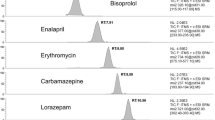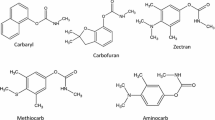Abstract
This work shows a novel analytical method for the simultaneous extraction of environmental emerging contaminants as benzenesulfonamides (BSAs), benzotriazoles (BTRs), and benzothiazoles (BTs) from water samples. Pristine multi-walled carbon nanotubes (MWCNTs), not yet tested for such analytes, are here employed as the sorbent phase for dispersive solid-phase extraction (d-SPE) followed by high-performance liquid chromatography/electrospray ionization tandem mass spectrometry (HPLC-HESI-MS/MS). Quantitative sorption is gained by treating 50 mL sample with 100 mg MWCNTs (2 g L−1) in 10 min contact, both in tap and raw river water. After sorption, the analytes are quantitatively desorbed by microwaves (20 min, 160 °C, 250 W) by using 5 mL methanol-ethylacetate-acetic acid (10:70:20, v/v), according to the indications obtained by a chemometric study. The extract is reduced to small volume before analysis, thus reaching overall enrichment factors up to 400. Recovery of the entire procedure, evaluated on tap and surface water samples spiked with 0.1/0.5–50 μg L−1 of each analyte, was in the range 70–116%, with excellent inter-day precision (RSD < 7%). Selectivity and firm analyte identification were assured by MRM detection, and suitable sensitivity was obtained for determination of these pollutants in actual matrices (experimental MDLs 30–170 ng L−1). The proposed analytical method was applied to the analysis of surface water samples, containing concentrations of these contaminants ranging from 100 ng L−1 to 2 μg L−1. Pristine MWCNTs proved to be a valid alternative to other commercial sorbents, both in terms of cost and sorption capacity.

Determination of benzenesulfonamides, benzotriazoles, and benzothiazoles in environmental waters by dispersive multi-walled carbon nanotube extraction prior HPLC-MS

Similar content being viewed by others
References
Herrero P, Borrull F, Pocurull E, Marcé RM. An overview of analytical methods and occurrence of benzotriazoles, benzothiazoles and benzenesulfonamides in the environment. Trend Anal Chem. 2014;62:46–55.
Herrero P, Borrull F, Pocurull E, Marcé RM. Efficient tandem solid-phase extraction and liquid chromatography-triple quadrupole mass spectrometry method to determine polar benzotriazole, benzothiazole and benzenesulfonamide contaminants in environmental water samples. J Chromatogr A. 2013;1309:22–32.
Bahnmüller S, Loi CH, Linge KL, von Gunten U, Canonica S. Degradation rates of benzotriazoles and benzothiazoles under UV-C irradiation and the advanced oxidation process UV/H2O2. Water Res. 2015;74:143–54.
McNeill KS, Cancilla DA. Detection of triazole deicing additives in soil samples from airports with low, mid, and large volume aircraft deicing activities. Bull Environ Contam Toxicol. 2009;82:265–9.
Speltini A, Sturini M, Maraschi F, Porta A, Profumo A. Fast low-pressurized microwave-assisted extraction of benzotriazole, benzothiazole and benezenesulfonamide compounds from soil samples. Talanta. 2016;147:322–7.
Salas D, Borrull F, Marcé RM, Fontanals N. Study of the retention of benzotriazoles, benzothiazoles and benzenesulfonamides in mixed-mode solid-phase extraction in environmental samples. J Chromatogr A. 2016;1444:21–31.
Asimakopoulos AG, Wang L, Thomaidis NS, Kannan K. Benzotriazoles and benzothiazoles in human urine from several countries: a perspective on occurrence, biotransformation, and human exposure. Environ Int. 2013;59:274–81.
Kinae N, Kawashima H, Kawane R, Saitou M, Saitou S, Tomita I. Detection and isolation of mutagenic substances from seawater. J Pharmacobiodyn. 1981;4:S63.
Sorahan T. Bladder cancer risks in workers manufacturing chemicals for the rubber industry. Occup Med (Oxf). 2008;58:496–501.
Birkholz DA, Stilson SM, Elliott HS. 2.11—analysis of emerging contaminants in drinking water—a review. In: Ahuja S, editor. Comprehensive water quality and purification. Waltham: Elsevier; 2014. p. 212–29.
Health Council of the Netherlands: Dutch expert committee on occupational standards (DECOS). 1,2,3-Benzotriazole. The Hague: Health Council of the Netherlands; 2000. publication no. 2000/14OSH.
Cancilla DA, Martinez J, Van Aggelen GC. Detection of aircraft deicing/antiicing fluid additives in a perched water monitoring well at an international airport. Environ Sci Technol. 1998;32:3834–5.
Hartell SI, Jordahl DM, Evans JE, May EB. Toxicity of aircraft deicer and anti-icer solutions to aquatic organisms. Environ Toxicol Chem. 1995;14:1375–86.
Schlumpf M, Cotton B, Conscience M, Haller V, Steinmann B, Lichtensteiger W. In vitro and in vivo estrogenicity of UV screens. Environ Health Perspect. 2001;109:239–44.
He T, Liang B, Liu W, Shin PKS, Wu RSS. Estrogenic potential of benzotriazole on marine medaka (Oryzias melastigma). Ecotoxicol Environ Saf. 2012;80:327–32.
Loi CH, Busetti F, Linge KL, Joll CA. Development of a solid-phase extraction liquid chromatography tandem mass spectrometry method for benzotriazoles and benzothiazoles in wastewater and recycled water. J Chromatogr A. 2013;1299:48–57.
Casado J, Nescatelli R, Rodríguez I, Ramil M, Marini F, Cela R. Determination of benzotriazoles in water samples by concurrent derivatization–dispersive liquid–liquid microextraction followed by gas chromatography–mass spectrometry. J Chromatogr A. 2014;1336:1–9.
Pena MT, Vecino-Bello X, Casais MC, Mejuto MC, Cela R. Optimization of a dispersive liquid–liquid microextraction method for the analysis of benzotriazoles and benzothiazoles in water samples. Anal Bioanal Chem. 2012;402:1679–95.
Naccarato A, Gionfriddo E, Sindona G, Tagarelli A. Simultaneous determination of benzothiazoles, benzotriazoles and benzosulfonamides by solid phase microextraction-gas chromatography-triple quadrupole mass spectrometry in environmental aqueous matrices and human urine. J Chromatogr A. 2014;1338:164–73.
Weiss S, Reemtsma T. Determination of benzotriazole corrosion inhibitors from aqueous environmental samples by liquid chromatography-electrospray ionization-tandem mass spectrometry. Anal Chem. 2005;77:7415–20.
Giger W, Schaffner C, Kohler HP. Benzotriazole and tolyltriazole as aquatic contaminants. 1. Input and occurrence in rivers and lakes. Environ Sci Technol. 2006;40:7186–92.
Voutsa D, Hartmann P, Schaffner C, Giger W. Benzotriazoles, alkylphenols and bisphenol A in municipal wastewaters and in the Glatt River, Switzerland. Environ Sci Pollut Res Int. 2006;13:333–41.
Jover E, Matamoros V, Bayona JM. Characterization of benzothiazoles, benzotriazoles and benzosulfonamides in aqueous matrix by solid-phase extraction followed by comprehensive two-dimensional gas chromatography couples to time of flight mass spectrometry. J Chromatogr A. 2009;1216:4013–9.
van Leerdam JA, Hogenboom AC, van der Kooi MME, de Voogt P. Determination of polar 1H-benzotriazoles and benzothiazoles in water by solid-phase extraction and liquid chromatography LTQ FT Orbitrap mass spectrometry. Int J Mass Spectrom. 2009;282:99–107.
Richter D, Massmann G, Taute T, Duennbier U. Investigation of the fate of sulfonamides downgradient of a decommissioned sewage farm near Berlin, Germany. J Contam Hydrol. 2009;106:183–94.
Wick A, Fink G, Ternes TA. Comparison of electrospray ionization and atmospheric pressure chemical ionization for multi-residue analysis of biocides, UV-filters and benzothiazoles in aqueous matrices and activated sludge by liquid chromatography-tandem mass spectrometry. J Chromatogr A. 2010;1217:2088–103.
Janna H, Scrimshaw MD, Williams RJ, Churchley J, Sumpter JP. From dishwasher to tap? Xenobiotic substances benzotriazole and TTR in the environment. Environ Sci Technol. 2011;45:3858–64.
Liu YS, Ying GG, Shareef A, Kookana RS. Simultaneous determination of benzotriazoles and ultraviolet filters in ground water, effluent and biosolid samples using gas chromatography–tandem mass spectrometry. J Chromatogr A. 2011;1218:5328–35.
Carpinteiro I, Abuin B, Ramil M, Rodríguez I, Cela R. Simultaneous determination of benzotriazole and benzothiazole derivatives in aqueous matrices by mixed-mode solid-phase extraction followed by liquid chromatography-tandem mass spectrometry. Anal Bioanal Chem. 2012;402:2471–8.
Xu W, Yan W, Licha T. Simultaneous determination of trace benzotriazoles and benzothiazoles in water by large-volume injection/gas chromatography–mass spectrometry. J Chromatogr A. 2015;1422:270–6.
Lin KYA, Lee WD. Self-assembled magnetic graphene supported ZIF-67 as a recoverable and efficient adsorbent for benzotriazole. Chem Eng J. 2016;284:1017–27.
Speltini A, Merli D, Profumo A. Analytical application of carbon nanotubes, fullerenes and nanodiamonds in nanomaterials-based chromatographic stationary phases: a review. Anal Chim Acta. 2013;783:1–16.
Socas-Rodríguez B, Herrera-Herrera AV, Asensio-Ramos M, Hernández-Borges J. Recent applications of carbon nanotube sorbents in analytical chemistry. J Chromatogr A. 2014;1357:110–46.
Herrero-Latorre C, Barciela-García J, García-Martín S, Peña-Crecente RM, Otárola-Jiménez J. Magnetic solid-phase extraction using carbon nanotubes as sorbents: a review. Anal Chim Acta. 2015;892:10–26.
González-García E, Gutiérrez Ulloa CE, de la Mata FJ, Marina ML, García MC. Sulfonate-terminated carbosilane dendron-coated nanotubes: a greener point of view in protein sample preparation. Anal Bioanal Chem. 2017;409:5337–48.
Corps Ricardo AI, Guzmán Bernardo FJ, Zougagh M, Rodríguez Martín-Doimeadios RC, Ríos Á. Magnetic nanoparticles—carbon nanotubes hybrid composites for selective solid-phase extraction of polycyclic aromatic hydrocarbons and determination by ultra-high performance liquid chromatography. Anal Bioanal Chem. 2017;409:5125–32.
Cheng C, Di S, Zhang W, Chen L, Tian Z, Zhou Z, et al. Determination of cyanamide residue in 21 plant-derived foods by liquid chromatography-tandem mass spectrometry. Food Chem. 2018;239:529–34.
Speltini A, Merli D, Dondi D, Paganini G, Profumo A. Improving selectivity in gas chromatography by chemically-modified multi-walled carbon nanotubes as stationary phase. Anal Bioanal Chem. 2012;403:1157–65.
Aral H, Çelik KS, Aral T, Topal G. Preparation of a novel ionic hybrid stationary phase by non-covalent functionalization of single-walled carbon nanotubes with amino-derivatized silica gel for fast HPLC separation of aromatic compounds. Talanta. 2016;149:21–9.
Zhang M, Qiu H. Progress in stationary phases modified with carbonaceous nanomaterials for high-performance liquid chromatography. Trends Anal Chem. 2015;65:107–21.
Herrera-Herrera AV, Gonzalez-Curbelo MA, Hernandez-Borges J, Rodríguez-Delgado MA. Carbon nanotubes applications in separation science: a review. Anal Chim Acta. 2012;734:1–30.
Speltini A, Sturini M, Maraschi F, Profumo A. Recent trends in the application of the newest carbonaceous materials for magnetic solid-phase extraction of environmental pollutants. Trends Environ Anal Chem. 2016;10:11–23.
Speltini A, Merli D, Quartarone E, Profumo A. Separation of alkanes and aromatic compounds by packed column gas chromatography using functionalized multi-walled carbon nanotubes as stationary phases. J Chromatogr A. 2010;1217:2918–24.
Speltini A, Maraschi F, Govoni R, Milanese C, Profumo A, Malavasi L, et al. Facile and fast preparation of low-cost silica-supported graphitic carbon nitride for solid-phase extraction of fluoroquinolone drugs from environmental waters. J Chromatogr A. 2017;1489:9–17.
Vazquez-Roig P, Segarra R, Blasco C, Andreu V, Picó Y. Determination of pharmaceuticals in soils and sediments by pressurized liquid extraction and liquid chromatography tandem mass spectrometry. J Chromatogr A. 2010;1217:2471–83.
Wang J, Li Z, Li S, Qi W, Liu P, Liu F, et al. Adsorption of Cu(II) on oxidized multi-walled carbon nanotubes in the presence of hydroxylated and carboxylated fullerenes. PLoS One. 2013;8:e72475.
Sanchez-Prado L, Garcia-Jares C, Dagnac T, Llompart M. Microwave-assisted extraction of emerging pollutants in environmental and biological samples before chromatographic determination. Trends Anal Chem. 2015;71:119–43.
Bruzzoniti MC, Maina R, Tumiatti V, Sarzanini C, Rivoira L, De Carlo RM. Fast low-pressure microwave assisted extraction and gas chromatographic determination of polychlorinated biphenyls in soil samples. J Chromatogr A. 2012;1265:31–8.
Acknowledgments
Dr. Ilenia Tredici is acknowledged for the scientific support in the SEM analysis performed at the CISRiC (Centro Interdipartimentale di Studi e Ricerche per la Conservazione del Patrimonio Culturale) of Pavia.
Author information
Authors and Affiliations
Corresponding author
Ethics declarations
Conflict of interest
The authors declare that they have no conflict of interest.
Electronic supplementary materials
ESM 1
Table S1 Physical-chemical parameters of the water samples used for d-SPE. Table S2 Optimized MRM conditions for the target analytes. Table S3 Variables experimental domain for the 23 factorial design. Table S4 Optimal desorption conditions for each class of compounds as indicated by the 23 factorial design. Figure S1 MRM chromatograms obtained by HPLC-HESI-MS/MS analysis of a standard solution prepared in methanol (500 μg L−1 of each compound). Figure S2 Results from sorption tests in presence of different amounts of (A) MWCNTs-COOH and (B) pristine MWCNTs (50 mL tap water, native pH, 50 μg L−1 of each compound); RSDs < 15% for MWCNTs-COOH, < 5% for pristine MWCNTs (n = 5). Figure S3 SEM images collected on (A) MWCNTs-COOH and (B) pristine MWCNTs. Figure S4 Plots of the coefficients of the model for BSAs (a), BTRs (b) and BTs (c) showing the significance of the variables investigated by the chemometric study. Stars indicate the significance of the coefficients (* p < 0.05, ** p < 0.01, *** p < 0.001), while error bars the confidence intervals (p = 0.05). Figure S5 Response surfaces obtained for BSAs, BTRs and BTs (for level codes see Table S3). (PDF 1.04 MB)
Rights and permissions
About this article
Cite this article
Speltini, A., Maraschi, F., Sturini, M. et al. Dispersive multi-walled carbon nanotubes extraction of benzenesulfonamides, benzotriazoles, and benzothiazoles from environmental waters followed by microwave desorption and HPLC-HESI-MS/MS. Anal Bioanal Chem 409, 6709–6718 (2017). https://doi.org/10.1007/s00216-017-0627-9
Received:
Revised:
Accepted:
Published:
Issue Date:
DOI: https://doi.org/10.1007/s00216-017-0627-9




